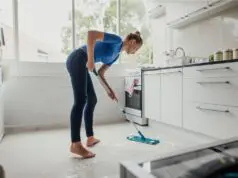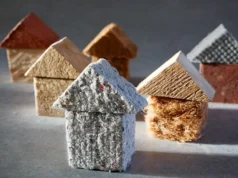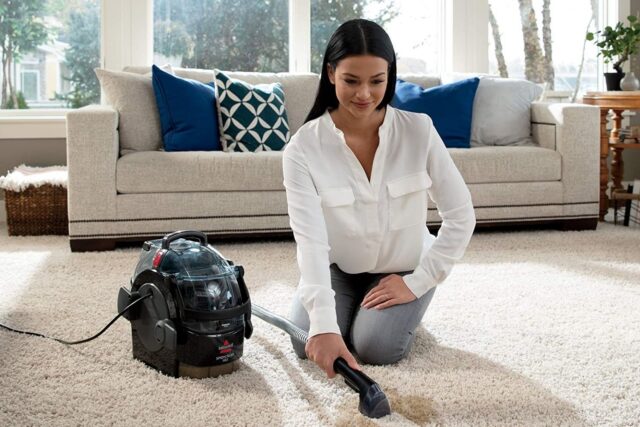
The living room chairs and sofa are what many families would consider a safe and cozy haven. Unfortunately, you’re not the only ones calling your coach ‘home.’ Dust, hair, food droplets, stains, and whatnot eventually find their way into the nooks and crannies of your furniture upholstery, many thanks to our not-so-careful ways.
Well, there’s really nothing we can do about it. After all, what’s “living” in the living room if we don’t spill beer, coffee, or soda in there? If you have kids and pets, then let the dirt war commence.
Like any other stuff in our possession, the only way for couches and sofas to survive is to clean them periodically. Yes, restoring your couch’s lounge-worthy status needs a lot of hard work, but it will keep your furniture spotless even though it has gone through cycles of abuse.
Know What You’re Dealing With First
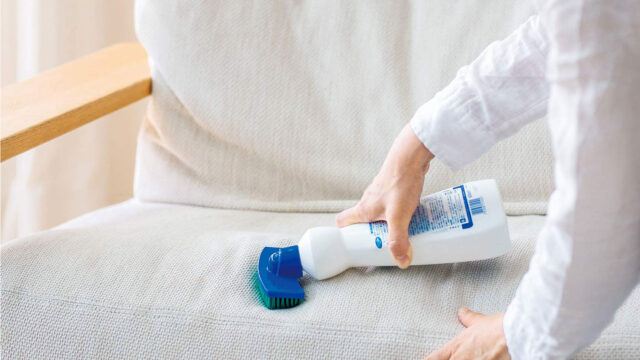
Sometime in 1969, furniture manufacturers in the United States added a tag coding system designed to help owners determine how to clean the upholsteries. It’s actually pretty straightforward and intuitive.
- “W” means you should only use water. Take out the covers and wash them according to the instructions.
- “S” means solvent-based cleaners are the recommendation. Spray the solvent-based cleaner lightly and then wipe with a clean sponge or cloth.
- “WS” means you can use either water or a solvent-based cleaner. An all-purpose cleaner like Simple Green is a water-based solvent, so it’s safe to use for upholstery with the WS tag. Sometimes, the tag may show “S/W” instead of “WS.”
- “X” is a warning not to use any water or solvent-based cleaners on the fabric. It is meant for light brushing or vacuum only. If in doubt, you may want to call a professional upholstery cleaning service on the best method of cleaning these types of fabric.
If you find any of these cleaning code tags in the upholstery, then you’re in good shape. If there isn’t any, you have to try testing in an unnoticeable part of the furniture to see how the fabric reacts. Do not ever try to turn aside from these instructions because if you do, you’ll be in for an unpleasant surprise.
Best Ways to Clean Upholstery
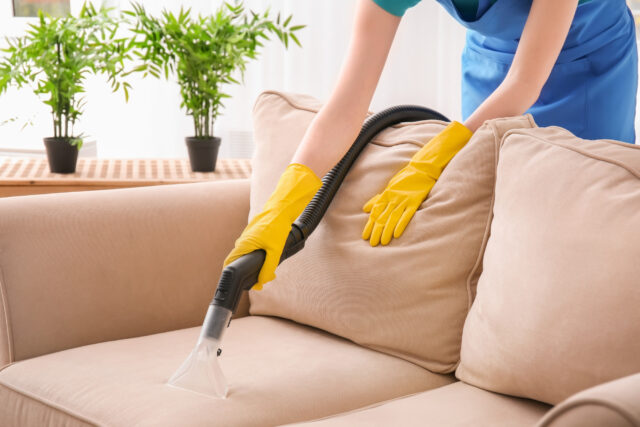
- Use a vacuum cleaner
When primarily dealing with dirt or dust, then using a vacuum cleaner is a no-brainer. Using the cleaner’s upholstery attachment, give the fabric a thorough rubdown working your way from the top using short, overlapping strokes from left to right.
Some materials like velvet, corduroy, or suede hold on to dirt like crazy, so the left-to-right technique is imperative to remove all dirt and dust. Vacuum under cushions and around seams using a crevice nozzle when you’re finished working on the main fabric. If you happen to have a can of compressed air laying around, use it to blow away dirt located on the button nooks and other crevices.
What if the vacuum doesn’t do the job you expected it to do? In this case, you have two choices — take the vacuum for a spin one more time, or it’s time to buy a new toy. Well, the latter is not the most practical option out there, but it may be worth the investment down the road, especially if you have expensive furniture.
What I’m talking about is purchasing an upholstery cleaner. It does not only remove stubborn dirt and stains, they are also antimicrobial. If you want to check the best upholstery cleaner machine in the market, please do so by clicking here.
- Use a Cleaning Solution
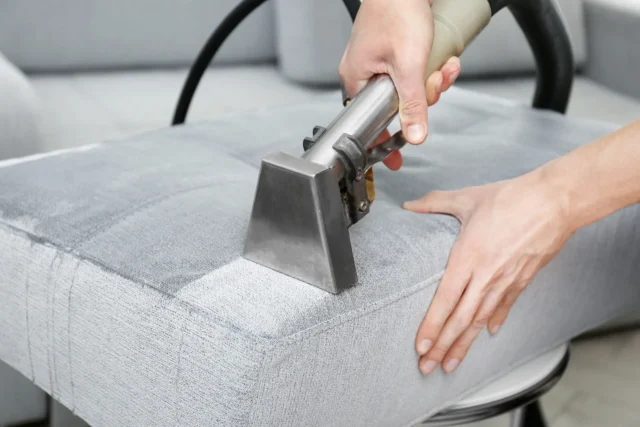
An amalgam that includes a cleaning solution is the best way to remove stains on upholstery unless, of course, the fabric has a “W” or “X” tag. You should take care of stains before and after a vacuuming session.
Before cleaning the overall upholstery, check it for caked-out stains such as mayonnaise or cheese. If you can remove it with some dull-pointed object like a credit card, then do it. Be aware that in doing this step, you shouldn’t be rubbing the stains but try to lift them away from the bottom. If you can’t, a fine toothbrush can effectively loosen dried matter before you can lift it off.
If solvent-based cleaners are allowed to clean the fabric, then you must prepare the cleaning solution. Combine 200 ml of warm water and about 50 ml of dishwashing liquid in a bowl and mix it until suds appear. Rub away the stain with a sponge and as you see the stain disperse, rotate to a clean area of the sponge. Rinse any remaining cleaning solution by dipping the sponge in clean water and rubbing the stained part. Allow it to air-dry.
When the upholstery needs more stain removal after vacuuming, you basically follow the same steps. However, since you already did the initial reconnaissance, concoct a less concentrated water-dishwashing liquid solution, depending on the need. The fabric must be patted completely with a dry cloth to absorb the extra moisture. Remember that too much water results in extra moisture. In turn, moisture invites more dirt and contaminants, so take the extra mile in making sure the fabric is dry.
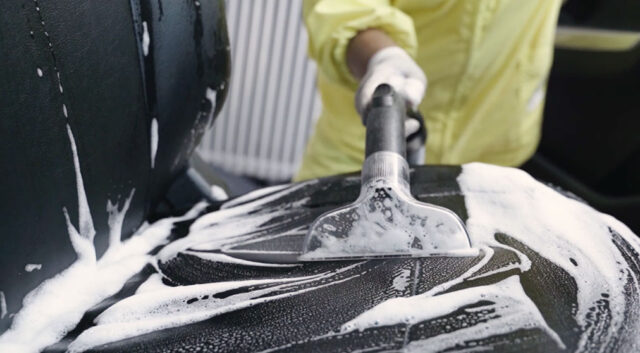
- Use a fast-drying upholstery shampoo
Most of the time, numbers 1 and 2 are enough to render your couches and sofa spotless after a brutal stretch. But then again, you might make the mistake of not removing excess moisture from the fabric, and now it’s discolored. What can you do?
The answer is a fast-drying upholstery shampoo. Mix it according to the instructions and allow it to form a foam. Wipe the discolored fabric in overlapping horizontal strokes in one direction. You may apply more if needed and when finished, let it sit out for no more than 10 minutes. Again, be sure to pat dry with a towel and perhaps use an electric fan or open the windows to dry the fabric quickly.
More Tips for Upholstery Cleaning
- Have a packet of baby wipes handy at all times. The idea is to quickly dispel and clean any spills on the furniture before it turns into a full-blown invasion. Baby wipes have a mixture of gentle soap and water, so it makes the perfect DIY upholstery cleaning tool.
- Baking soda will do wonders. Minor stains should first be tried out with baking soda. It’s a natural, chemical-free solution that easily lifts trapped and locked stains. Again, remember to wipe away any leftover residues, or it’ll invite more dirt army to the camp.
- Be gentle and do not scrub. This is self-explanatory. Scrubbing the upholstery hard can pound the stain even further, or at worst, damage the fabric.
- Use water sparingly, especially when rinsing. Excess moisture is the worst enemy of upholstery fabric. It invites more dirt, and it could cause discoloration. When rinsing, ensure that you do not flood the fabric with water, but instead, use it sporadically until you get the desired results.
- Clean the upholstery often. The secret to durable upholstery is to clean regularly. It also adds to the beauty to your home and contributes to the wellness of everyone in the family.
- When in doubt, leave it to the pros. Don’t take chances, especially when your piece is expensive or has sentimental value. Consult a professional cleaning service or let them take over if it seems too overwhelming.
Bottom Line: Best Ways to Clean Upholstery

As the adage goes, “One who maintains cleanliness keeps away diseases.” While we may always think that we are safe in the walls of our own home, dirty furniture could abruptly end that story. It becomes a breeding ground for bacteria and a sanctuary for dust, dirt, and grime if not cleaned regularly.
The best way to clean upholstery is by vacuuming or using an upholstery cleaning machine. These tools ensure that pet hair and deep-seated dust are extracted. If the fabric has stains, a mixture of warm water and dishwashing liquid often do the trick. When discoloration occurs, apply a fast-drying upholstery shampoo. Just be sure to rinse all the residue behind and refrain from using too much water. Keep all these tips and instructions in mind, and you’ll get right back to your sofa-snuggling ways in no time.

